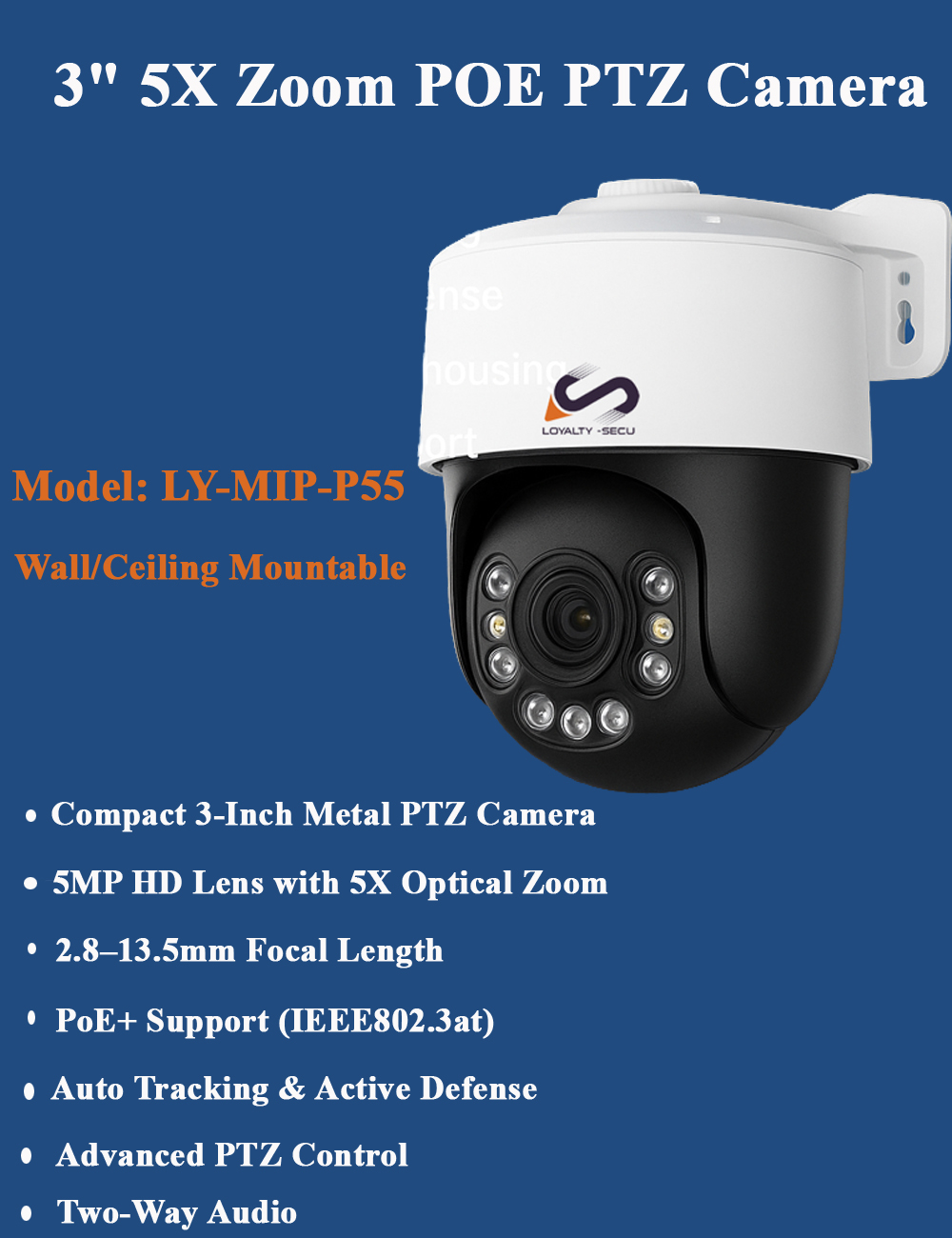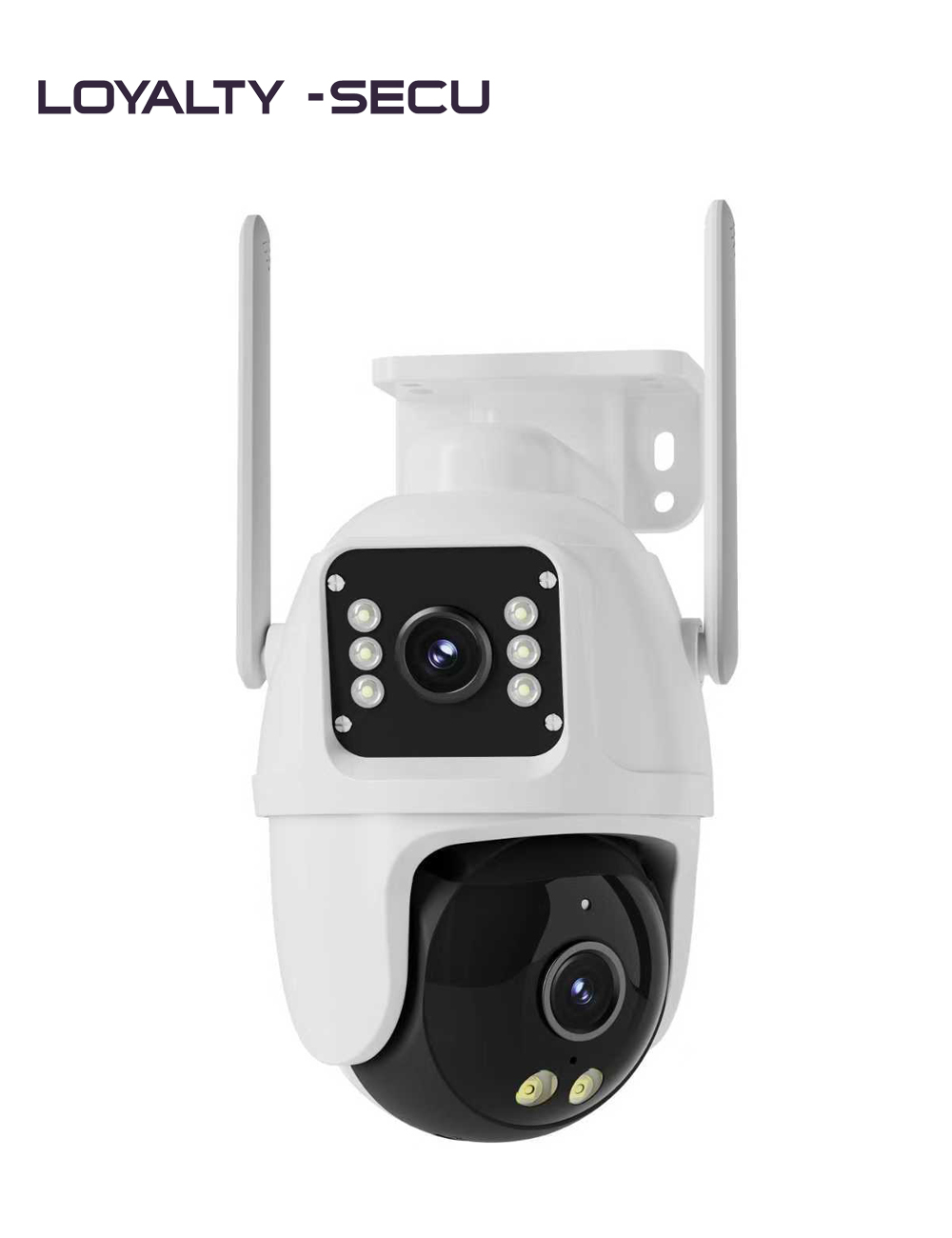
To achieve effective video surveillance in environments lacking traditional network infrastructure, 4G cellular network cameras have emerged.
4G cellular network cameras, also known as 4G SIM card cameras or 4G LTE cameras, are mobile surveillance devices that utilize the 4G LTE cellular network to transmit video data, enable real-time viewing, and send instant alerts.
Their core advantage lies in their independence from Wi-Fi or wired Ethernet connections, operating by inserting a SIM card and subscribing to a corresponding cellular data plan. This makes them ideal for remote areas or temporary locations lacking stable internet connections, such as farms, construction sites, vacation homes, or any area covered by mobile network signals.
To further enhance their deployment flexibility, many 4G cameras are battery-powered and often come with solar panel options for truly wireless operation and continuous power supply.
Fixed 4G cameras are a type of 4G cellular network camera characterized by a static, non-movable lens and a fixed field of view. Once installed, their monitoring perspective is set and cannot be adjusted via remote control. To change the monitored area, the camera must be physically repositioned. These cameras focus on providing continuous, reliable monitoring of a specific area.
What Are the Core Functional Differences Between 4G PTZ and Fixed 4G Cameras?
Although both 4G PTZ cameras and fixed 4G cameras rely on cellular networks for connectivity, they differ fundamentally in core surveillance functions, primarily in terms of movement capability, monitoring coverage, and zoom ability.
Movement Capability
- 4G PTZ Cameras: Possess dynamic control capabilities, allowing users to precisely control the camera’s horizontal (Pan) and vertical (Tilt) rotation via remote applications or software. Many advanced models also feature auto-tracking, automatically following moving objects (like people, vehicles, or animals) within their field of view, or patrolling according to preset paths and schedules (preset tours).
- Fixed 4G Cameras: The viewing angle is static. The monitoring direction determined at installation cannot be changed remotely. Adjusting the monitored area requires manually reinstalling or repositioning the camera.
Monitoring Coverage
- 4G PTZ Cameras: Due to their movement capability, PTZ cameras offer significantly wider potential monitoring coverage. Many models can achieve near or complete 360° horizontal rotation and 90° to 180° vertical tilt. Theoretically, one PTZ camera can cover a large area that would require multiple fixed cameras, making it particularly cost-effective when monitoring large open spaces.
- Fixed 4G Cameras: Their monitoring range is limited to their fixed Field of View (FOV), which is determined by the camera lens’s focal length (e.g., wide-angle lenses offer a broader view, standard lenses are narrower). Achieving comprehensive coverage of large or complex areas typically requires deploying multiple fixed cameras.
However, a critical limitation of PTZ cameras must be noted: their coverage is dynamic, not simultaneous. The camera can only observe and record the direction its lens is pointing at any given moment. When it pans or zooms to observe one area, other areas within its potential range become temporary blind spots, potentially missing events occurring there (the “coverage gap” issue). In contrast, fixed cameras, while limited in angle, provide continuous, uninterrupted monitoring of their designated area.
Zoom Capability
- 4G PTZ Cameras: Typically equipped with Optical Zoom. This means the camera’s lens components physically move to magnify distant objects while maintaining the original image resolution and clarity. Optical zoom magnification can be very high, such as 20x, 25x, 30x, or even higher, enabling PTZ cameras to clearly capture distant details like facial features or license plate numbers. Some PTZ cameras may also offer digital zoom concurrently.
- Fixed 4G Cameras: Primarily rely on Digital Zoom. Digital zoom is not true optical magnification but rather software-based cropping and enlarging of a specific area of the image. This method leads to pixelation and a significant decrease in clarity as the magnification increases. While high-resolution (e.g., 4K) fixed cameras perform slightly better with minor digital zoom, their effectiveness is far inferior to optical zoom.
Summarizing these functional differences, the core trade-off is between flexibility and consistency. PTZ cameras offer unparalleled dynamic flexibility—the ability to remotely change perspective, perform powerful optical zooms to investigate details, and even automatically track targets. But this flexibility comes at the cost of continuous, simultaneous coverage of the entire potential monitoring area. Fixed cameras provide absolute monitoring consistency for their designated zone, ensuring it’s always in view, but lack adaptability and remote adjustment capabilities.
Optical zoom capability is a significant advantage of PTZ cameras over fixed ones. It makes effective detail identification possible at long distances, which is crucial for many security and management applications (like identity confirmation, event investigation), and this is precisely where the digital zoom of fixed cameras falls short.
Simultaneously, the “coverage gap” issue of PTZ cameras is a weakness that cannot be ignored. Relying solely on a single PTZ camera to secure a large area can be risky. Effective deployment strategies often involve combining PTZ cameras with fixed cameras to cover critical entrances or areas, or utilizing the PTZ’s auto-tracking and preset tour features to minimize blind spots. This indicates that PTZ camera deployment requires more careful planning than fixed cameras.

What Are the Typical Application Scenarios and Suitable Environments for 4G PTZ and Fixed 4G Cameras?
The choice between 4G PTZ cameras and fixed 4G cameras largely depends on specific application requirements and deployment environments. Both are suitable for locations lacking traditional network infrastructure, but their functional differences dictate their respective optimal use cases.
4G PTZ Camera Application Scenarios
Leveraging their wide coverage potential, powerful zoom capabilities, and remote control flexibility, 4G PTZ cameras are particularly suitable for the following scenarios:
- Monitoring Large Open Areas: Such as farms, ranches, large construction sites, parking lots, ports, airport perimeters, large storage areas, etc.. In these environments, using a few PTZ cameras might be more cost-effective and manageable than deploying numerous fixed cameras.
- Scenarios Requiring Active Monitoring and Target Tracking: For example, needing to remotely track intruders, vehicles, or wildlife activity, or needing to zoom in on specific details for investigation or management. This includes event security, border patrol, sports broadcast support, construction progress detail inspection, and agricultural/livestock management (e.g., observing livestock behavior, checking crop growth, monitoring irrigation systems).
- Remote Areas Lacking Wi-Fi and Power: Utilizing 4G connectivity and solar/battery power, PTZ cameras can operate in completely off-grid environments.
- Temporary Deployment Needs: Their relatively easy installation and mobility make them suitable for temporary events, short-term projects, or situations requiring rapid deployment of surveillance.
Fixed 4G Camera Application Scenarios
Fixed 4G cameras excel in the following scenarios due to their simplicity, reliability, and cost-effectiveness:
- Monitoring Specific Critical Points: Scenarios requiring continuous, uninterrupted monitoring of a fixed location, such as remote entrances/exits, gates, specific equipment (like fuel tanks, generators), important material storage points, or critical passages with limited visibility.
- “Set-and-Forget” Remote Monitoring: Providing reliable video recording and alert functions in remote locations where active tracking or frequent angle adjustments are unnecessary. For example, monitoring unattended cabins, remote villas, signal towers, or environmental monitoring stations.
- Budget-Constrained Remote Monitoring Projects: When 4G connectivity is necessary, but the budget doesn’t support the higher cost of PTZ cameras, fixed 4G cameras offer a more economical solution for basic remote viewing and alert needs.
- Supplementing PTZ Systems: Used in conjunction with PTZ cameras, fixed cameras can continuously cover critical areas (like main entrances), compensating for potential coverage gaps created when the PTZ camera pans or zooms.
Environmental Suitability (Common to Both)
Whether PTZ or fixed, the choice of a 4G camera is based on a common premise: the deployment location lacks reliable Wi-Fi or wired network connectivity. They typically utilize battery and/or solar power, making them suitable for areas without mains electricity. However, the performance of both types heavily depends on the 4G cellular network signal strength and stability at the installation site.
Therefore, the key determinant in selection is the nature of the monitoring task. If the goal is wide-area situational awareness, active investigation, or tracking in a remote environment, then 4G PTZ is the more appropriate choice. If the goal is continuous, reliable monitoring of specific points, or if budget and simplicity are primary concerns, then fixed 4G cameras are preferable.
It’s worth noting that 4G PTZ cameras, with their dynamic capabilities, can support more complex remote operational tasks, such as active farm management or detailed engineering inspections, which go beyond the passive security role typically assigned to fixed cameras, offering higher operational value.

What Are the Pros and Cons of 4G PTZ and Fixed 4G Cameras?
When choosing between a 4G PTZ camera and a fixed 4G camera, it’s crucial to fully understand their respective advantages and disadvantages. These two types of cameras present significant trade-offs in terms of functionality, cost, reliability, and ease of use.
4G PTZ Camera
Pros:
- Wide Area Coverage & Flexibility: A single camera can monitor vast areas, reducing the total number of cameras needed, and allows remote adjustment of the viewing angle to suit different needs.
- Powerful Zoom Capability: Optical zoom magnifies distant details without losing image quality, crucial for identifying targets.
- Active Tracking Capability: Some models feature auto-tracking of moving targets, enhancing monitoring efficiency.
- Full Remote Control: All functions (pan, tilt, zoom, presets, etc.) can be operated remotely via app or software.
- Potential Deterrent Effect: The visible movement of the camera might have a stronger psychological deterrent effect on potential intruders.
Cons:
- Higher Initial Cost: Due to the inclusion of sophisticated mechanical PTZ structures, zoom lenses, and associated electronics, their purchase price is typically significantly higher than fixed 4G cameras.
- Potential Coverage Blind Spots: Cannot simultaneously monitor its entire potential field of view; creates blind spots when panning or zooming. Often requires fixed cameras as supplements.
- Mechanical Complexity & Durability Issues: Contains motors and other moving parts, making it more prone to mechanical failure, especially during long-term operation in harsh outdoor environments. May require more frequent maintenance or replacement.
- Relatively Complex Installation & Setup: While basic 4G connection setup is simple, configuring PTZ functions (like presets, tour paths, tracking parameters) adds complexity.
- Potentially Higher Data Consumption: Actively using PTZ functions (manual control, auto-tracking) for live viewing or recording consumes more cellular data than static fixed cameras.
- Control Latency: Remote PTZ control over cellular networks may experience delays (lag), affecting the precision of real-time tracking.
Fixed 4G Camera
Pros:
- Lower Initial Cost: Compared to equivalent 4G PTZ cameras, their purchase price is generally lower.
- Simplicity & High Reliability: Simple structure with no moving parts, lower risk of mechanical failure, generally more durable with fewer maintenance needs.
- Consistent Coverage: Provides uninterrupted, predictable monitoring of its designated area. Events within the area are not missed due to camera movement.
- Easy Installation & Setup: Installation and configuration processes are typically very straightforward and user-friendly, suitable for DIY.
- Relatively Lower Data Consumption: Due to the lack of active control features, their data usage pattern is usually more predictable, less likely to experience surges caused by frequent PTZ operations.
Cons:
- Limited Field of View: Monitoring range is fixed and cannot be adjusted remotely. Covering large areas requires deploying multiple cameras.
- Inability to Remotely Adjust View: Cannot change the monitoring direction or track targets remotely based on changing situations.
- Limited Zoom Capability: Relies on digital zoom, which severely degrades image quality upon magnification, making it difficult to identify distant details.
- Poor Flexibility: Cannot adapt to dynamically changing monitoring needs unless physically repositioned.
Summary Comparison Table of Pros and Cons
| Feature | 4G PTZ Camera | Fixed 4G Camera |
| Coverage | Wide potential range (up to 360°), flexible angle | Fixed range, limited angle |
| Consistency | Dynamic, risk of blind spots | Continuous, uninterrupted monitoring of designated area |
| Zoom Capability | Powerful (Optical Zoom), clear distant details | Limited (Digital Zoom), quality degrades with zoom |
| Flexibility | High, remote control, adapts to dynamic needs | Low, requires physical adjustment to change view |
| Initial Cost | Higher | Relatively Lower |
| Setup Complexity | Basic simple, PTZ config slightly more complex | Very simple, often plug-and-play |
| Reliability/Maint | Lower (mechanical parts prone to wear) | Higher (no moving parts) |
| Data Consumption | Potentially Higher (depends on PTZ usage frequency) | Relatively Lower and Predictable |
| Control Latency | Possible (affects real-time control) | Not Applicable |
This comparison clearly illustrates the core trade-off between the two camera types. Choosing a 4G PTZ means compromising on cost, potential reliability risks, and coverage consistency to gain advanced features and flexibility. Choosing a fixed 4G means prioritizing cost-effectiveness, simplicity, and reliability, but accepting limitations in coverage and functionality. This trade-off also extends to long-term costs; PTZ cameras not only have a higher initial investment but their potentially higher data consumption and greater risk of maintenance/replacement can also increase their Total Cost of Ownership (TCO).
Conclusion
In conclusion, both 4G PTZ and fixed 4G cameras are effective tools for solving monitoring challenges in network-deprived environments, but they serve different needs and priorities. By carefully evaluating monitoring objectives, environmental conditions, budget constraints, and the trade-offs between functionality and reliability, users can select the solution that best meets their specific requirements.



